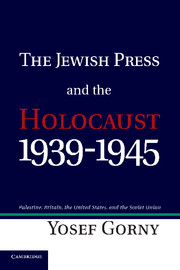 The Jewish Press and the Holocaust, 1939–1945
The Jewish Press and the Holocaust, 1939–1945 Book contents
- Frontmatter
- Contents
- Preface
- Introduction
- Part I From Concern to Outcry – 1939–1942
- Part II The Illusion Dashed – 1942–1945
- Part III The Individual Confronts the Horror
- 7 Yitzhak Gruenbaum – “The Main Culprit”
- 8 The Intellectuals’ Delusional Optimism
- 9 Between Lidice and Majdanek
- 10 Remarks on the Continuing Jewish Angst
- Conclusion
- Bibliography
- Index
- References
10 - Remarks on the Continuing Jewish Angst
from Part III - The Individual Confronts the Horror
Published online by Cambridge University Press: 05 November 2011
- Frontmatter
- Contents
- Preface
- Introduction
- Part I From Concern to Outcry – 1939–1942
- Part II The Illusion Dashed – 1942–1945
- Part III The Individual Confronts the Horror
- 7 Yitzhak Gruenbaum – “The Main Culprit”
- 8 The Intellectuals’ Delusional Optimism
- 9 Between Lidice and Majdanek
- 10 Remarks on the Continuing Jewish Angst
- Conclusion
- Bibliography
- Index
- References
Summary
This chapter conducts a comparative discussion of the phenomenon of antisemitism in the United States during World War II (1941–1945) from two points of view: the childhood memories of the American-Jewish author Philip Roth, as articulated in his book The Plot against America, and the attitude of the Yiddish- and English-language Jewish press toward this phenomenon in the same years.
Both perspectives are subjective. The former embodies childhood memories as reconstructed and worked through by a renowned author, which, according to the critics of his widely influential book, are very much on-target. The second subjective point of view belongs to the American-Jewish press, especially that in Yiddish, which at the time still represented the culture of much of American Jewry as evidenced by its daily circulation. Published mainly in New York, the Yiddish-language press was distributed in more than 400,000 copies per day. I define the Jewish press’ response as subjective because, concurrently, it sustained the East European cultural tradition in its national outlook and its responses to antisemitism and strongly underscored the new and changing status of the Jews in the democratic United States and its tolerant and liberal society.
American antisemitism during World War II was surely a special phenomenon in respect to the history of European antisemitism, the memory of which was carried to the United States by Jewish immigrants. It was unique in that it erupted powerfully during the war years, precisely as the United States fought the Nazi Fascist regime, and even gathered strength toward the end of the war, when the downfall of this murderous regime was no longer in doubt.
To gauge the uniqueness of the American antisemitic model, we need to compare it with at least two contemporary European models: Nazi antisemitism, a strategic doctrine geared to ousting the Jews from general society, leading incrementally to the Final Solution; and Polish antisemitism, a hybrid creature of discriminatory politics in various fields, government-led but resting on broad public support, deriving its ideological justification from nationalist intellectual circles.
- Type
- Chapter
- Information
- The Jewish Press and the Holocaust, 1939–1945Palestine, Britain, the United States, and the Soviet Union, pp. 251 - 266Publisher: Cambridge University PressPrint publication year: 2011


